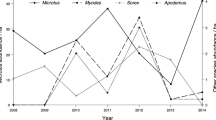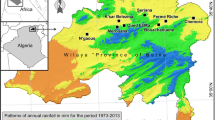Abstract
Based on a long-term dataset (1999–2010), we investigated how the availability of main prey affects the breeding density and food ecology of the Tengmalm’s owl (Aegolius funereus) in the Czech Republic. In particular, we assessed the role of Microtus voles and Apodemus mice in the diet, based on the main predictions of the optimal diet theory that the diet composition depends on the availability of the main prey. We found that (i) the Tengmalm’s owl exhibited no numerical response to the availability of Microtus voles and Apodemus mice in the field; (ii) the availability of Apodemus mice in the field positively affected their proportion in the diet (26 %), and despite a high proportion of Microtus voles in the owls’ diet (47 %), no relationship was found between their availability in the field and proportion in the diet; (iii) the proportion of Apodemus mice was negatively correlated to the proportion of Microtus voles, Sorex shrews and birds in the diet, but no similar relationship was detected for Microtus voles; (iv) the reproductive output of Tengmalm’s owls was positively correlated to the proportion of Apodemus mice in the diet, as well as to Apodemus mice and Microtus vole availability in the field; and (v) diet diversity and diet overlap were not significantly affected by the abundance of Apodemus mice and Microtus voles. Therefore, the validity of these main optimal diet theory predictions was not confirmed, especially for Microtus vole prey, due to an opportunistic choice between Apodemus mice and Microtus voles. We suggest that the reproductive output of nocturnal raptors in Central Europe may be less dependent on Microtus vole supply than that of their northern counterparts.




Similar content being viewed by others
References
Anděra M, Horáček I (2005) Determining our mammals. Sobotáles, Prague (in Czech)
Aulagnier S, Haffner P, Mitchell-Jones AJ, Moutou F, Zima J (2008) Mammals of Europe. AC Black Publishers Ltd, London
Beneš B (1986) Mammals in the diet of Tengmalm’s owl (Aegolius funereus) from the Rejvíz (Jeseníky Mountains). Čas Slez Muz Opava 35:219–225 (in Czech with English abstract)
Brommer JE, Pietiäinen H, Kolunen H (2002) Reproduction and survival in a variable environment: ural owls (Strix uralensis) and the three-year vole cycle. Auk 119:544–550
Davidová L (2009) Diet of Tengmalm’s Owl (Aegolius funereus) in the Ore Mountains in 2006. Master’s thesis, Czech University of Life Sciences Prague, Prague (in Czech with English abstract)
Dvořáčková Š (2009) Feeding ecology of Tengmalm’s Owl (Aegolius funereus) in the Ore Mountains (2004–2005). Master’s thesis, Czech University of Life Sciences Prague, Prague (in Czech with English abstract)
Galushin VM (1974) Synchronous fluctuations in populations of some raptors and their prey. Ibis 116:127–134
Halle S, Stenseth NC (2000) Activity patterns in small mammals—an ecological approach. Ecological Studies, vol 141. Analysis and synthesis. Springer, Berlin
Hansson L, Henttonen H (1985) Gradients in density variations of small rodents: the importance of latitude and snow cover. Oecologia 67:394–402
Holý P (2002) Feeding ecology of Tengmalm’s Owl (Aegolius funereus) in air-pollution damaged areas of the Ore Mountains. Master’s thesis, Czech University of Life Sciences Prague, Prague (in Czech with English abstract)
Hörnfeldt B, Carlsson BG, Lögrfen O, Eklund U (1990) Effect of cyclic food supply on breeding performance in Tengmalm’s owl (Aegolius funereus). Can J Zool 68:522–530
Jędrzejewski W, Jędrzejewska B (1996) Rodent cycles in relation to biomass and productivity of ground vegetation and predation in the Palearctic. Acta Theriol 41:1–34
Jędrzejewski W, Szymura A, Jędrzejewska B (1994) Reproduction and food of the buzzard Buteo buteo in relation to the abundance of rodents and birds in Białowieża National Park, Poland. Ethol Ecol Evol 6:179–190
Karell P, Ahola K, Karstinen T, Zolei A, Brommer JE (2009) Population dynamics in a cyclic environment: consequences of cyclic food abundance on tawny owl reproduction and survival. J Anim Ecol 78:1050–1062
Kloubec B, Vacík R (1990) Outline of food ecology of Tengmalm’s owl (Aegolius funereus L.) in Czechoslovakia. Tichodroma 3:103–125 (in Czech with English abstract)
Komrsková P (2009) Feeding ecology of Tengmalm’s Owl (Aegolius funereus) in the Ore Mountains (2007–2008). Master’s thesis, Czech University of Life Sciences Prague, Prague (in Czech with English abstract)
Korpimäki E (1981) On the ecology and biology of Tengmalm’s owl Aegolius funereus in Southern Ostrobothnia and Soumenselkä, western Finland. Acta Univ Oul A Sci Rer Nat 118:1–84
Korpimäki E (1984) Population dynamics of birds of prey in relation to fluctuations in small mammal populations in western Finland. Ann Zool Fenn 21:287–293
Korpimäki E (1985a) Diet of the Kestrel Falco tinnunculus in the breeding season. Ornis Fenn 62:130–137
Korpimäki E (1985b) Prey choice strategies of the kestrel Falco tinnunculus in relation to available small mammals and other Finnish birds of prey. Ann Zool Fenn 22:91–104
Korpimäki E (1986a) Diet variation, hunting habitat and reproductive output of the Kestrel Falco tinnunculus in the light of the optimal diet theory. Ornis Fenn 63:84–90
Korpimäki E (1986b) Seasonal changes in the food of Tengmalm’s owl Aegolius funereus in western Finland. Ann Zool Fenn 23:339–344
Korpimäki E (1986c) Gradients in population fluctuations of Tengmalm’s owl Aegolius funereus in Europe. Oecologia 69:195–201
Korpimäki E (1987) Clutch size, breeding success and brood size experiments in Tengmalm’s owl Aegolius funereus: a test of hypotheses. Ornis Scan 18:277–284
Korpimäki E (1988) Diet of breeding Tengmalm’s Owls Aegolius funereus: long-term changes and year-to-year variation under cyclic food conditions. Ornis Fenn 65:21–30
Korpimäki E (1992) Diet composition, prey choice and breeding success of long-eared owls: effects of multiannual fluctuations in food abundance. Can J Zool 70:2373–2381
Korpimäki E (1994) Rapid or delayed tracking of multi-annual vole cycles by avian predators? J Anim Ecol 63:619–628
Korpimäki E, Hakkarainen H (1991) Fluctuating food-supply affects the clutch size of Tengmalm’s owl independent of laying date. Oecologia 85:543–552
Korpimäki E, Tolonen P, Valkama J (1994) Functional responses and load-size effect in central place foragers: data from kestrel and some general comments. Oikos 69:504–510
Kostrzewa R, Kostrzewa A (1991) Winter weather, spring and summer density, and subsequent breeding success of Eurasian Kestrels, Common Buzzards, and Northern Goshawks. Auk 108:342–347
Kuhk R (1969) Schlüpfen and Entwicklung der Nestjungen beim Rauhfusskauzes (Aegolius funereus). Bonn Zool Beitr 20:141–150 (in German)
Manly BF, McDonald LL, Thomas DL, McDonald TL, Erickson WP (2002) Resource selection by animals: Statistical design and analysis for field studies, 2nd edn. Kluwer Academic Publishers, Dordrecht
Millon A, Bretagnolle V (2008) Predator population dynamics under a cyclic prey regime: numerical responses, demographic parameters and growth rates. Oikos 117:1500–1510
Niethammer J, Krapp F (1978) Handbuch der Säugetiere Europas. Band 1/I. Wiesbaden, Akademisches Verlagsges (in German)
Niethammer J, Krapp F (1986) Handbuch der Säugetiere Europas. Band 2/II. Wiesbaden, Aula Verlag (in German)
Norrdahl K, Korpimäki E (2002) Seasonal changes in the numerical responses of predators to cyclic vole populations. Ecography 25:428–438
Pelikán J (1971) Quadrat size and density estimates of small mammals. Folia Zool 20:139–152
Petty SJ, Patterson IJ, Anderson DIK, Little B, Davison M (1995) Numbers, breeding performance, and diet of the sparrowhawk Accipiter nisus and merlin Falco columbarius in relation to cone crops and seed-eating finches. Forest Ecol Manag 79:133–146
Petty SJ, Lambin X, Sherrat TN, Thomas CJ, Mackinnon JL, Coles CF, Davison M, Little B (2000) Spatial synchrony in the field vole Microtus agrestis in a coniferous forest in northern England: the role of vole-eating raptors. J Appl Ecol 37(suppl. 1):136–147
Pianka ER (1973) The structure of lizard communities. Annu Rev Ecol Syst 4:53–74
Pokorný J (2000) The diet of the Tengmalm’s Owl (Aegolius funereus) in North Bohemian mountain areas damaged by immissions. Buteo 11:107–114 (in Czech with English abstract)
Pokorný J, Kloubec B, Obuch J (2003) Comparison of Tengmalm’s Owl Aegolius funereus diet in several Czech mountain areas. Vogelwelt 124:313–323
Potapov ER (1997) What determines the population density and reproductive success of rough-legged buzzards, Buteo lagopus, in the Siberian tundra? Oikos 78:362–376
Poulin RG, Wellicome TI, Todd LD (2001) Synchronous and delayed numerical responses of a predatory bird community to a vole outbreak on the Canadian prairies. J Raptor Res 35:288–295
Pulliam HR (1974) On the theory of optimal diets. Am Nat 108:59–74
Pyke GH (1984) Optimal foraging theory: a critical review of theory and tests. Annu Rev Ecol Syst 15:523–575
Rymešová D (2006) Diet composition and nest success of Tengmalm’s owl (Aegolius funereus) in the Žďárské vrchy Protected Landscape Area. Buteo 15:49–57 (in Czech with English abstract)
Salamolard M, Butet A, Leroux A, Bretagnolle V (2000) Responses of an avian predator to variations in prey density at a temperate latitude. Ecology 81:2428–2441
Schelper W (1972) Ein Beitrag zur Biologie des Rauhfusskauzes Aegolius funereus (L.). Beitr Naturk Nieders 25:77–83 (in German)
Schelper W (1989) Zur Brutbiologie, Ernährung und Populationsdynamik des Rauhfusskauzes Aegolius funereus im Kaufunger Wald (Südniedersachsen). Vogelk Berichte Nieders 21:33–53 (in German)
Schoener TW (1971) Theory of feeding strategies. Annu Rev Ecol Syst 2:369–404
Schueler FW (1972) A new method of preparing owl pellets: boiling in NaOH. Bird Band 43:142
Schwerdtfeger O (1988) Analyse der Depotbeute in den Bruthöhlen des Rauhfusskauzes (Aegolius funereus). Die Vogelwelt 109:176–181 (in German with English abstract)
Shannon CE, Weaver W (1963) The mathematical theory of communication. University of Illinois Press, Urbana
Sobotová L (2008) Feeding ecology of Boreal Owl (Aegolius funereus) in polluted areas of the Krušné hory (Ore Mountains). Master’s thesis, Czech University of Life Sciences Prague, Prague (in Czech with English abstract)
StatSoft, Inc. (2008) STATISTICA (data analysis software system), version 8.0. http://www.statsoft.com
Steenhof K, Kochert MN (1988) Dietary responses of three raptor species to changing prey densities in a natural environment. J Anim Ecol 57:37–48
Sulkava P, Sulkava V (1971) Die nistzeitliche Nahrung des Rauhfusskauzes Aegolius funereus in Finland 1958–1967. Ornis Fenn 48:117–124 (in German)
Tkadlec E, Stenseth NC (2001) A new geographical gradient in vole population dynamics. Proc R Soc B Biol Sci 268:1547–1552
Village A (1981) The diet and breeding of long-eared owls in relation to vole numbers. Bird Study 28:215–224
Village A (1990) The Kestrel. T & A D Poyser, London
Vopálka P (2012) Feeding ecology of Boreal Owl (Aegolius funereus) in polluted areas of the Krušné hory (Ore Mountains). Master’s thesis, Czech University of Life Sciences Prague, Prague (in Czech with English abstract)
Zárybnická M, Sedláček O, Korpimäki E (2009) Do Tengmalm’s owls alter parental feeding effort under varying conditions of main prey availability? J Orn 150:231–237
Zárybnická M, Riegert J, Šťastný K (2011) Tengmalm’s owl diet composition: a comparison of camera surveillance and pellet analysis. Ornis Fenn 88:147–153
Zárybnická M, Korpimäki E, Griesser M (2012) Dark or short nights: differential latitudinal constraints in nestling provisioning patterns of a nocturnally hunting bird species. PLoS ONE 7(5):e36932. doi:10.1371/journal.pone.0036932
Acknowledgments
We are grateful to V. Bejček, F. Sedláček, J. Zima and J. Vilímová for their assistance in determining small-mammal abundance in the field, and L. Schröpfer for helping determine birds in the diet. We also thank J. Zárybnický, J. Hanel, V. Tomášek, M. Kouba, A. Hýlová and V. Dvořák for their field assistance. T. Saitoh, P. Karell, P. Leskinen, J. Zima and an anonymous reviewer gave valuable comments on the manuscript. This work has been supported by grants from the Czech University of Life Sciences Prague (VGA 41110-1312-3137, 41110-1312-3127, CIGA 41110-1313-3156), the Ministry of Education, Youth and Sports of the Czech Republic (FRVS 41110-1161-1625, MSM 6007665801), the Ministry of the Environment (MŽP 41110-1643-6457, 41110-1644-6464), and Forests of the Czech Republic (LČR 41110-1644-6404).
Author information
Authors and Affiliations
Corresponding author
Rights and permissions
About this article
Cite this article
Zárybnická, M., Riegert, J. & Št’astný, K. The role of Apodemus mice and Microtus voles in the diet of the Tengmalm’s owl in Central Europe. Popul Ecol 55, 353–361 (2013). https://doi.org/10.1007/s10144-013-0367-4
Received:
Accepted:
Published:
Issue Date:
DOI: https://doi.org/10.1007/s10144-013-0367-4




